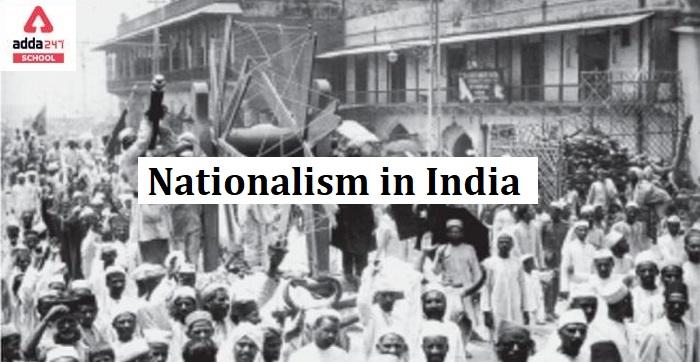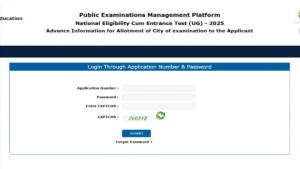Table of Contents
Nationalism in India
When the First World War broke out in Europe in 1919, it had far-reaching implications around the world. The notion of nationalism emerged in Europe in combination with the emergence of new states. It also had an influence on the thinking of the people of Europe. They gained an understanding of their identity and sense of belonging. New nationalist emblems and ideas created new relationships and redefined community borders. It may have been claimed to spark the war for India’s freedom and Nationalism in India has taken birth. The advent of the Satyagraha and Non-Cooperation movement sparked the spirit of Nationalism in India. On this page, we have given complete details about Nationalism in India. Read the whole article to get complete information.
Nationalism in India- World War I
Since World War I, we can trace the emergence of India’s national movement. Because Britishers colonised people in India and many other countries, including Vietnam, they had a common adversary, which brought them together to resist British control in India. During World War I, India as a British territory experienced several economic and political challenges. A huge sum of money was required to conduct war, which was obtained by imposing customs taxes and an income tax on Indians. Many regions of our country experienced food shortages and the development of the influenza pandemic, adding fuel to the fire in our battle against the colonial administration.
Nationalism in India: Satyagraha
Mahatma Gandhi returned to India from South Africa and launched the Satyagraha campaign in January 1915. Satyagraha highlighted the importance of truth and the necessity to seek it. Nonviolence, according to Mahatma Gandhi, may win a struggle and unite all Indians. He travelled to Champaran, Bihar, to encourage peasants to fight the harsh plantation system in 1917. In the same year, he organised a satyagraha to help the peasants of Gujarat’s Kheda area. Mahatma Gandhi travelled to Ahmedabad in 1918 to organise a satyagraha movement among cotton mill employees.
Nationalism in India: The Rowllat Act
Despite the unanimous opposition of the Indians, the Rowlatt Act was passed through the Imperial Legislative Council in 1919. Gandhiji resolved to start a countrywide satyagraha in opposition to the Rowlatt Act. The horrific Jallianwalla Bagh event occurred when people were gathered to discuss the 1919 Act. Crowds rushed to the streets of north Indian towns as word of Jallianwalla Bagh spread across the area. The government reacted with harsh repression, attempting to humiliate and frighten the people. As violence erupted, Mahatma Gandhi ordered a halt to the movement. After the Jallianwala Bagh incident, Mahatma Gandhi was persuaded that in order to organise such a movement, Hindus and Muslims needed to be brought closer together. He accomplished this by bringing up the Khilafat issue.
Nationalism in India: Non-Cooperation Movement
Gandhiji saw that in order to establish a successful national mass movement, Hindus and Muslims needed to be united. Muhammad Ali and Shaukat Ali, two Muslim brothers, founded the Khilafat movement. Gandhiji chose to begin the Non-cooperation campaign with the Khilafat movement during the Calcutta session of Congress in 1920. The concept of gathering Hindus and Muslims together to protect Khalifa’s temporal sovereignty was one of the most significant milestones in Nationalism in India. In the non-cooperation movement, Mahatma Gandhi ordered to boycott of foreign commodities, clothing, colleges, law courts, civil services, government titles, schools, and council elections. Members of Congress were first hesitant to boycott council elections, but later in the 1920 Congress session, they become part of the non-cooperation movement and boycott elections.
Nationalism in India: Civil Disobedience Movement
Gandhi’s well-known Dandi March sparked the Civil Disobedience Movement. On 12th March 1930, Gandhi and 78 other Ashram members set off on foot from the Sabarmati Ashram in Ahmadabad for Dandi, a place 385 kilometres away from Ahmadabad. They reached Dandi on 6th April 1930. Mahatama Gandhi violated the salt law in that location. The Civil Disobedience Movement spread like fire after the violation of salt law by Gandhi across the country. Salt production spread across the country during the first phase of the civil disobedience movement, becoming a symbol of the people’s rejection of the government.
Features of the Civil Disobedience Movement
- People from rural areas and a large number of women register their participation in Civil Disobedience Movement
- This was the first countrywide movement since all previous ones had been restricted to cities only.
- This movement’s motto was nonviolence, and it did not give up despite repeated British oppression.
- The satyagraha campaign was headed by well-known women like Avantikabai Gokhale, Lilavati Munshi, Kasturba Gandhi, Kamaladevi Chattopadhyay, and Hansaben Mehta.
Causes of Civil Disobedience Movement
- A commission chaired by Motilal Nehru drafted a new constitution in Calcutta in 1928. In 1928, the INC asked that the British government recognise Nehru’s Report. The report’s major focus was to grant India Dominion Status. It threatened and blackmailed the British government if they did not accept the report, civil disobedience movement would be started.
- The Simon committee, established by the British government in 1927 to formalise India’s constitution and consisting exclusively of British members, was rejected by the Indian National Congress and other political and social organisations.
Drawbacks of the Civil Disobedience Movement
- Except in Nagpur, industrial employees were not in great numbers.
- Muslims were less inclined to engage as a result of communal leaders’ advice and the government’s efforts to promote communalism as a counter-nationalism strategy.
Nationalism in India- Chapter 2 Class 10 History
Indian nationalism, developed as a concept during the Indian independence movement, fought against the colonial British Raj. In this chapter, students will get to know the story from the 1920s and study about the nonCooperation and Civil Disobedience Movements. Students will also get to explore how Congress sought to develop the national movement, how different social groups participated in the movement, and how nationalism captured the imagination of people. Learn more about Nationalism in India by exploring CBSE Class 10 History Notes Chapter 2. These CBSE notes are comprehensive and detailed, yet concise enough to glance through for exam preparations.
Nationalism in India- The First World War, Khilafat and Non-Cooperation in details
In India, the growth of modern nationalism is connected to the anti-colonial movement. Due to colonialism, many different groups shared bonds together, which were forged by the Congress under Mahatma Gandhi.
The war created a new economic and political situation in the years after 1919. Income tax was introduced and the prices of custom duties were doubled between 1913 and 1918, which led to a very difficult life for common people. In 1918-19 crops failed in India, resulting in shortage of food accompanied by an influenza epidemic. At this stage, a new leader appeared and suggested a new mode of struggle.
The Idea of Satyagraha
In January 1915, Mahatma Gandhi returned to India from South Africa and started the movement Satyagraha. Satyagraha emphasised the power of truth and the need to search for truth. According to Mahatma Gandhi, people can win a battle with non-violence which will unite all Indians. In 1917, he travelled to Champaran in Bihar to inspire the peasants to struggle against the oppressive plantation system. In the same year, he organised satyagraha to support the peasants of the Kheda district of Gujarat. In 1918, Mahatma Gandhi went to Ahmedabad to organise a satyagraha movement amongst cotton mill workers.
The Rowlatt Act
In 1919, Mahatma Gandhi launched a nationwide satyagraha against the proposed Rowlatt Act. The Act gives the government enormous powers to repress political activities and allowed detention of political prisoners without trial for two years. The British government decided to clamp down on nationalists by witnessing the outrage of the people. On April 10th, police in Amritsar fired on a peaceful procession, which provoked widespread attacks on banks, post offices and railway stations. Martial law was imposed and General Dyer took command.
On 13th April, the Jallianwala Bagh incident took place. A large crowd gathered in the Jallianwala Bagh where a few people came to protest against the government’s new repressive measures, while some came to attend the annual Baisakhi fair. General Dyer blocked all the exit points and opened fire on the crowd killing hundreds. After the Jallianwala Bagh massacre, people became furious and went on strikes, clashes with police and attacks on government buildings. Mahatma Gandhi had to call off the movement as it was turning into a violent war.
Mahatma Gandhi then took up the Khilafat issue by bringing Hindus and Muslims together. The First World War ended with the defeat of Ottoman Turkey. In March 1919, a Khilafat Committee was formed in Bombay. In September 1920, Mahatma Gandhi convinced other leaders of the need to start a non-cooperation movement in support of Khilafat as well as for swaraj.
Why Non-cooperation?
According to Mahatma Gandhi, British rule was established in India with the cooperation of Indians. Non-cooperation movement is proposed in stages. It should begin with the surrender of titles that the government awarded and a boycott of civil services, army, police, courts and legislative councils, schools and foreign goods. After many hurdles and campaigning between the supporters and opponents of the movement, finally, in December 1920, the Non-Cooperation Movement was adopted.
Class 10 students can now join the board exam preparation batch by Adda247 and ace their board exam.
Nationalism in India- Differing Strands within the Movement
In January 1921, the Non-Cooperation-Khilafat Movement began. In this movement, various social groups participated, but the term meant different things to different people.
The Movement in the Towns
The middle-class started the movement and thousands of students, teachers, headmasters left government-controlled schools and colleges, and lawyers gave up their legal practices. On the economic front, the effects of non-cooperation were more dramatic. The production of Indian textile mills and handlooms went up when people started boycotting foreign goods. However, this movement slowed down due to a variety of reasons such as Khadi clothes are expensive, less Indian institutions for students and teachers to choose from, so they went back to government schools and lawyers joined back government courts.
Rebellion in the Countryside
The Non-Cooperation Movement spread to the countryside where peasants and tribals were developing in different parts of India. The peasant movement started against talukdars and landlords who demanded high rents and a variety of other cesses. It demanded reduction of revenue, abolition of begar and social boycott of oppressive landlords.
Jawaharlal Nehru in June 1920, started going around the villages in Awadh to understand their grievances. In October, he along with a few others set up the Oudh Kisan Sabha and within a month 300 branches had been set up. In 1921, the peasant movement spread and the houses of talukdars and merchants were attacked, bazaars were looted and grain boards were taken over.
In the early 1920s, a militant guerrilla movement started spreading in the Gudem Hills of Andhra Pradesh. The government started closing down forest areas due to which their livelihood was affected. Finally, the hill people revolted, which was led by Alluri Sitaram Raju who claimed that he had a variety of special powers.
Nationalism in India- Swaraj in the Plantations
For plantation workers in Assam, freedom meant the right to move freely in and out and retaining a link with the village from which they had come. Under the Inland Emigration Act of 1859, plantation workers were not permitted to leave the tea gardens without permission. After they heard of the Non-Cooperation Movement, thousands of workers left the plantations and headed home. But, unfortunately, they never reached their destination and were caught by the police and brutally beaten up.
Towards Civil Disobedience
In February 1922, the Non-Cooperation Movement was withdrawn because Mahatma Gandhi felt that it was turning violent. Some of the leaders wanted to participate in elections to the provincial councils. Swaraj Party was formed by CR Das and Motilal Nehru. In the late 1920s Indian politics again shaped because of two factors. The first effect was the worldwide economic depression and the second effect was the falling agricultural prices. The Statutory Commission was set up to look into the functioning of the constitutional system in India and suggest changes. In 1928, Simon Commission arrived in India and it was greeted by the slogan ‘Go back Simon’. In December 1929, under the presidency of Jawaharlal Nehru, the Lahore Congress formalised the demand of ‘Purna Swaraj’ or full independence for India. It was declared that 26 January 1930 would be celebrated as Independence Day.
The Salt March and the Civil Disobedience Movement
On 31 January 1930, Mahatma Gandhi sent a letter to Viceroy Irwin stating eleven demands. Among the demands, the most stirring of all was the demand to abolish the salt tax which is consumed by the rich and the poor. The demands needed to be fulfilled by 11 March or else Congress would start a civil disobedience campaign. The famous salt march was started by Mahatma Gandhi accompanied by 78 of his trusted volunteers. The march was over 240 miles, from Gandhiji’s ashram in Sabarmati to the Gujarati coastal town of Dandi. On 6 April he reached Dandi, and ceremonially violated the law, manufacturing salt by boiling seawater. This marked the beginning of the Civil Disobedience Movement.
The movement spread across the world and salt law was broken in different parts of the country. Foreign cloth was boycotted, peasants refused to pay revenue and in many places, forest law was violated. In April 1930, Abdul Ghaffar Khan, a devout disciple of Mahatma Gandhi was arrested. Mahatma Gandhi was arrested a month later which led to attacks on all structures that symbolised British rule. By witnessing the horrific situation, Mahatma Gandhi decided to call off the movement and entered into a pact with Irwin on 5 March 1931. Gandhi-Irwin Pact, Gandhiji consented to participate in a Round Table Conference in London. When the conference broke down, Mahatma Gandhi returned to India disappointed and relaunched the Civil Disobedience Movement. It continued for almost a year, but by 1934 it lost its momentum.
How Participants saw the Movement
The Patidars of Gujarat and the Jats of Uttar Pradesh were active in the movement. They became enthusiastic supporters of the Civil Disobedience Movement. But they were deeply disappointed when the movement was called off in 1931. So when the movement was restarted in 1932, many of them refused to participate. The poorer peasants joined a variety of radical movements, often led by Socialists and Communists.
To organise business interests, the Indian Industrial and Commercial Congress in 1920 and the Federation of the Indian Chamber of Commerce and Industries (FICCI) in 1927 was formed. The industrialists attacked colonial control over the Indian economy and supported the Civil Disobedience Movement when it was first launched. Some of the industrial workers did participate in the Civil Disobedience Movement. In 1930 and 1932 railway workers and dock workers were on strike.
Another important feature of the Civil Disobedience Movement was the large-scale participation of women. But, for a long time, Congress was reluctant to allow women to hold any position of authority within the organisation.
The Limits of Civil Disobedience
Dalits, addressed as untouchables were not moved by the concept of Swaraj. Mahatma Gandhi used to call them harijans or the children of God, without whom swaraj could not be achieved. He organised satyagraha for the untouchables but they were keen on a different political solution to the problems of the community. They demanded reserved seats in educational institutions and a separate electorate.
Dr B.R. Ambedkar, who organised the Dalits into the Depressed Classes Association in 1930, clashed with Mahatma Gandhi at the second Round Table Conference by demanding separate electorates for Dalits. The Poona Pact of September 1932, gave the Depressed Classes (later to be known as the Scheduled Castes) reserved seats in provincial and central legislative councils. After the decline of the Non-Cooperation-Khilafat movement, Muslims felt alienated from the Congress due to which the relations between Hindus and Muslims worsened.
Muhammad Ali Jinnah was willing to give up the demand for separate electorates if Muslims were assured reserved seats in the Central Assembly and representation in proportion to population in the Muslim-dominated provinces. Nevertheless, the hope of resolving the issue at the All Parties Conference in 1928 disappeared when M.R. Jayakar of the Hindu Mahasabha strongly opposed efforts at compromise.
Nationalism in India- The Sense of Collective Belonging
Nationalism spreads when people begin to believe that they are all part of the same nation. History and fiction, folklore and songs, popular prints and symbols, all played a part in the making of nationalism. Finally, in the twentieth century, the identity of India came to be visually associated with the image of Bharat Mata. Bankim Chandra Chattopadhyay created the image and in the 1870s he wrote ‘Vande Mataram’ as a hymn to the motherland.
Abanindranath Tagore painted his famous image of Bharat Mata portrayed as an ascetic figure; she is calm, composed, divine and spiritual. In late-nineteenth-century India, nationalists began recording folk tales sung by bards and they toured villages to gather folk songs and legends. During the Swadeshi movement in Bengal, a tricolour flag (red, green and yellow) was designed which had eight lotuses representing eight provinces of British India, and a crescent moon, representing Hindus and Muslims. By 1921, Gandhiji designed the Swaraj flag, a tricolour (red, green and white) and had a spinning wheel in the centre, representing the Gandhian ideal of self-help.
Nationalism in India- Conclusion
In the first half of the twentieth century, various groups and classes of Indians came together for the struggle of independence. The Congress under the leadership of Mahatma Gandhi attempted to resolve differences and ensure that the demands of one group did not alienate another. In other words, what was emerging was a nation with many voices wanting freedom from colonial rule.
Nationalism in India- Class 10 History Chapter 2 Important Questions
Question 1. Explain the three main events that took place under Gandhi’s Satyagraha Movement.
Ans: The three main events that took place under Gandhi’s Satyagraha movement were as follows:
- Champaran Satyagraha in 1917
- Kheda Satyagraha in 1918
- Mill Workers Support in 1918
Question 2. When did Gandhiji return from South Africa?
Ans: Gandhiji returned from South Africa in 1915.
Question 3. What was observed on April 6th, 1919?
Ans: 6th April 1919 was observed as the Satyagraha Day where people went on fast and strike across the nation.
Question 4. Write down the effect of the Jallianwala Bagh Massacre.
Ans: The effects of the Jallianwala Bagh Massacre were as follows:
- Government buildings were attacked by the people
- There were clashes with police officers and numerous strikes
- The British suppressed the agitations with brutality and humiliation
- The villages were bombed and destroyed
Question 5. In which session of the INC was the demand of ‘Purna Swaraj’ formalized?
Ans: ‘Purna Swaraj’ was formalized in the 1929 session of the Indian National Congress at Lahore.
Question 6. What did the Rowlatt Act impose?
Ans: According to the Rowlatt Act, the British Government had the power to prohibit the political activities and detain the political leaders without trial for up to two years.
Question 7. Who started the Khilafat Movement and why?
Ans: It was started by Muhammad Ali and Shakaut Ali. It was started in response to the unjust treatment given to the Caliph of the Ottoman Empire who was regarded by the Muslims around the world as their Spiritual Leader.
Question 8. Which act prohibited the plantation workers from leaving the tea garden without prior permission?
Ans: The Inland Immigration Act passed in 1859. The plantation workers couldn’t leave the tea gardens without prior permission from their superiors which they seldom got upon asking.
Question 9. Who wrote the book ‘Hind Swaraj’?
Ans: Mahatma Gandhi wrote the book Hind Swaraj.
Question 10. What is the meaning of ‘Beggar’?
Ans: Beggar means forced labor without income.



 NEET City Intimation Slip 2025 Available...
NEET City Intimation Slip 2025 Available...
 PSEB 12th Result 2025 @pseb.ac.in, Punja...
PSEB 12th Result 2025 @pseb.ac.in, Punja...
 CUET UG Date Sheet 2025 @cuet.nta.nic.in...
CUET UG Date Sheet 2025 @cuet.nta.nic.in...

